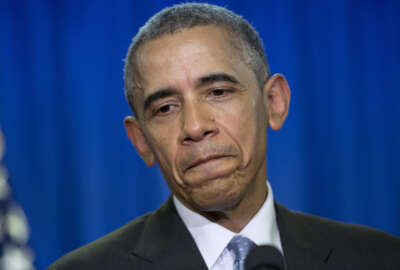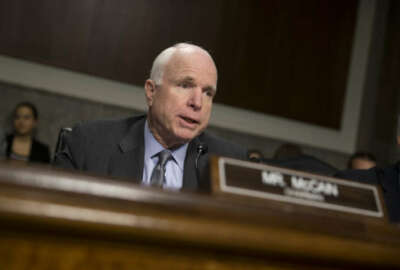
Congress hits back at White House over NDAA
Congressional staffers addressed some of the President's concerns with the 2017 defense authorization bill.
Congressional insiders are parrying criticisms from the Obama administration over the massive 2017 defense bills passed by the House and Senate.
Nestled inside the bills are sweeping organizational reforms for the Defense Department, changes to the acquisition system and a budgetary flea-flicker that pays for an increase in troops.
The White House has already threatened to veto both the House and Senate versions of the bill.
“Last time I looked, the President proposes and the Congress disposes of the budget so that’s what we’ve done and if he’s going to veto it then he certainly is operating under false pretenses because we are taking care of the warfighter. We want to make sure those kids go into theater and go into harm’s way with what they need,” Bob Simmons, staff director of the House Armed Services Committee told reporters June 21.
The President isn’t the only roadblock the bills will be facing, however. The two bills still need to go to conference to find common ground.
The areas that will need the most work are the way the bills allocate funds, defense health reforms and acquisition changes, said Chris Brose, staff director of the Senate Armed Services Committee during a speech at AEI in Washington.
Both Brose and Simmons said they were confident the two houses could come to an agreement. After all, the defense authorization bill has passed more than 50 years in a row.
The staffers would not say when exactly the legislative bodies would get around to finding that common ground.
But despite the differences between the House and Senate, the two staff directors kept their attention on the executive branch’s problems with the bills.
The White House has particularly taken issue with the way the House bill plans to fund initiatives that go beyond what the President requested in his 2017 budget.
The committee plans to take $18 billion from Overseas Contingency Operations (OCO) and move it into the base budget. That $18 billion would be used to fund an increased military pay raise and to bolster troop levels by 27,000.
What would be left in OCO is $41 billion, instead of the original $59 billion requested by the President. That’s enough to cover the wars until April 2017. Congress would then have to pass another wartime supplemental to pay for the wars after April.
Simmons said Congress took the exact same approach to the budget in 2008 in order to give newly seated President Barack Obama discretion over how wartime funds would be allocated.
“We think it’s an absolutely rational way of going and then the candidates, whoever ends up being the president, can just make their own assessment of what the foreign policy is and what direction they want to take the country and ask us for the funding of that effort,” Simmons said.
Then again, the 2008 Congress didn’t have sequestration and the issue of capped domestic spending to add to its budgetary debates.
The White House brought that up in its criticism of the bill last month.
“Not only is this approach dangerous, but it is also wasteful. The bill would buy excess force structure without the money to sustain it, effectively creating hollow force structure that would undermine DOD’s efforts to restore readiness. Furthermore, the bill’s funding approach attempts to unravel the dollar-for-dollar balance of defense and non-defense funding increases provided by the Bipartisan Budget Act of 2015, threatening future steps needed to reverse over $100 billion of future sequestration cuts to DoD,” the statement of administrative policy says.
That’s not the only area where the legislative branch felt rebuffed by the President.
The administration accused the committee of micromanaging in the bill after it made the biggest reforms to DoD’s organization in 30 years.
The bill cuts the position of Undersecretary of Defense for Acquisition, Technology and Logistics and separates its functions in an attempt to free up research from day-to-day acquisition burdens. It also empowers the Defense Secretary to use resources more cross functionally.
Brose said he found it ironic that the executive branch felt Congress was meddling considering Congress created the current organizational structure.
“My hope is that the department will recognize that Congress is a critical stakeholder in this and this is something that we can work together very effectively,” Brose said.
Simmons said the restructuring is a continuation of what Congress did last year in decentralizing acquisition power by giving more authority to military service chiefs.
“The [Defense Secretary] needs a mechanism to integrate across functions in a way that allows him to pull relevant components out of those functional areas of expertise, centers of excellence, bring them together and integrate them in a way that’s focused on achieving a mission,” Brose said.
Simmons said the Defense Secretary will then have more CEO-type power to regulate the military service chiefs so they don’t “run amok.”
Despite the bill passing with regularity over the past half century, it’s still not a sure bet. Last year, President Obama vetoed the bill because it boosted defense spending without increasing domestic spending.
That veto was averted by the passage of the budget deal.
Copyright © 2025 Federal News Network. All rights reserved. This website is not intended for users located within the European Economic Area.
Scott Maucione is a defense reporter for Federal News Network and reports on human capital, workforce and the Defense Department at-large.
Follow @smaucioneWFED




